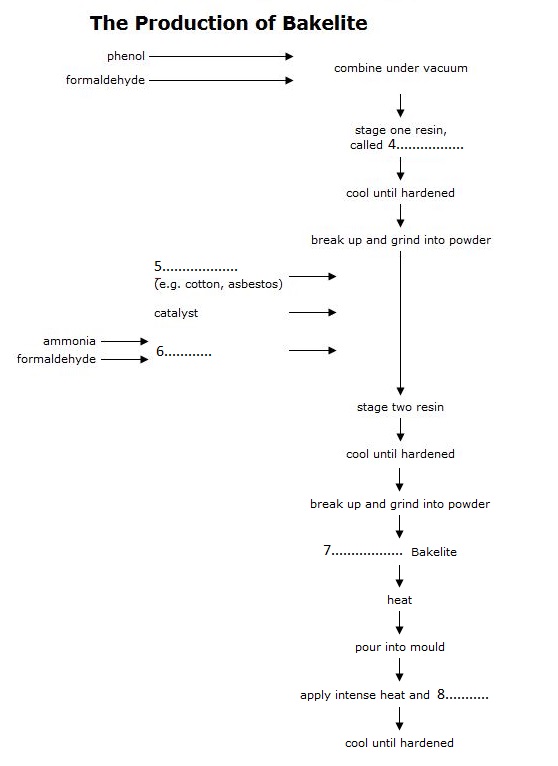DỊCH HOÀN THIỆN ĐỀ THI IELTS READING VÀ GIẢI THÍCH ĐÁP ÁN:
Bakelite
In 1907, Leo Hendrick Baekeland, a Belgian scientist working in New York, discovered and patented a revolutionary new synthetic material. His invention, which he named 'Bakelite', was of enormous technological importance, and effectively launched the modern plastics industry. ĐOẠN 1
Năm 1907, Leo Hendrick Baekeland, một nhà khoa học người Bỉ làm việc tại New York, đã phát hiện và có bằng sáng chế cho một vật liệu tổng hợp mới mang tính cách mạng. Phát minh của ông được đặt tên là 'Bakelite', có tầm quan trọng công nghệ to lớn và đã khởi động hiệu quả ngành công nghiệp nhựa hiện đại.
The term 'plastic' comes from the Greek plassein, meaning 'to mould'. Some plastics are derived from natural sources, some are semi-synthetic (the result of chemical action on a natural substance), and some are entirely synthetic, that is, chemically engineered from the constituents of coal or oil. Some are 'thermoplastic', which means that, like candlewax, they melt when heated and can then be reshaped. Others are 'thermosetting': like eggs, they cannot revert to their original viscous state, and their shape is thus fixed forever, Bakelite had the distinction of being the first totally synthetic thermosetting plastic. ĐOẠN 2
Thuật ngữ 'nhựa' xuất phát từ tiếng Hy Lạp plassein, có nghĩa là 'đúc'. Một số chất dẻo có nguồn gốc từ các nguồn tự nhiên, một số là chất bán tổng hợp (kết quả của tác động hóa học lên một chất tự nhiên) và một số là chất tổng hợp hoàn toàn, tức là được xử lý hóa học từ các thành phần của than hoặc dầu. Một số là 'nhựa dẻo', có nghĩa là, giống như sáp nến, chúng tan chảy khi đun nóng và sau đó có thể định hình lại. Những loại khác là 'nhựa rắn': giống như trứng, chúng không thể trở lại trạng thái nhầy ban đầu và do đó hình dạng của chúng được cố định mãi mãi. Bakelite có điểm khác biệt là loại nhựa rắn tổng hợp hoàn toàn đầu tiên.
The history of today's plastics begins with the discovery of a series of semi-synthetic thermoplastic materials in the mid-nineteenth century. The impetus behind the development of these early plastics was generated by a number of factors - immense technological progress in the domain of chemistry, coupled with wider cultural changes, and the pragmatic need to find acceptable substitutes for dwindling supplies of 'luxury' materials such as tortoise-shell and ivory. ĐOẠN 3
Lịch sử của nhựa ngày nay bắt đầu với việc phát hiện ra một loạt vật liệu nhiệt dẻo bán tổng hợp vào giữa thế kỷ XIX. Động lực đằng sau sự phát triển của những loại nhựa ban đầu này được tạo ra bởi một số yếu tố - tiến bộ công nghệ to lớn trong lĩnh vực hóa học, cùng với những thay đổi văn hóa rộng lớn hơn và nhu cầu thực tế để tìm các vật liệu thay thế có thể chấp nhận được cho nguồn cung cấp vật liệu 'xa xỉ' đang cạn kiệt như mai rùa và ngà voi.
Baekeland's interest in plastics began in 1885 when, as a young chemistry student in Belgium, he embarked on research into phenolic resins, the group of sticky substances produced when phenol (carbolic acid) combines with an aldehyde (a volatile fluid similar to alcohol). He soon abandoned the subject, however, only returning to it some years later. By 1905 he was a wealthy New Yorker, having recently made his fortune with the invention of a new photographic paper. While Baekeland had been busily amassing dollars, some advances had been made in the development of plastics. The years 1899 and 1900 had seen the patenting of the first semi-synthetic thermosetting material that could be manufactured on an industrial scale. In purely scientific terms, Baekeland's major contribution to the field is not so much the actual discovery of the material to which he gave his name, but rather the method by which a reaction between phenol and formaldehyde could be controlled, thus making possible its preparation on a commercial basis. On 13 July 1907, Baekeland took out his famous patent describing this preparation, the essential features of which are still in use today. ĐOẠN 4

1. Mua bộ đề gần 400 bài ielts reading - Dịch và giải chi tiết Chỉ 199k bao gồm toàn bộ đề trong bộ Cambridge ( từ bộ 1 -19) và nhiều đề thi thực tế ( xem danh sách 400 đề ielts reading tại đây). Xem bài mẫu tại đây, Bài mẫu 1, bài mẫu 2, bài mẫu 3. Giải đề bao gồm phần dịch bài đọc, dịch phần câu hỏi, giải thích chi tiết, ( chỉ có thể tải, in phần đề để luyện tập, phần giải chi tiết và dịch chỉ xem online).
>>>>> Đặc biệt tặng kèm Dịch và giải chi tiết bộ đề Ielts listening từ Cam 10-18 và tặng kèm hơn 300 đề Ielts thực tế ( không có lời giải chi tiết chỉ có đề và đáp án) ( khác với bộ 400 đề ở trên). Vui lòng điền thông tin theo form tại đây và thanh toán theo thông tin CK trong form.
2. Đặc biệt dành tặng 100 bạn hoàn thành buổi học thử miễn phí khóa học Ielts Speaking online 1 kèm 1, các bạn sẽ được tặng bộ đề 400k bài Ielts reading và bộ đề Ielts Listening bộ Cam từ 10-18 gồm bài dịch và giải chi tiết, giải thích từ vựng khó ( thời hạn sử dụng trong vòng 2 tháng). Xem thông tin khóa học Ielts Speaking online 1 kèm 1 và đăng ký học thử tại đây.
The original patent outlined a three-stage process, in which phenol and formaldehyde (from wood or coal) were initially combined under vacuum inside a large egg-shaped kettle. The result was a resin known as Novalak, which became soluble and malleable when heated. The resin was allowed to cool in shallow trays until it hardened, and then broken up and ground into powder. Other substances were then introduced: including fillers, such as woodflour, asbestos or cotton, which increase strength and moisture resistance, catalysts (substances to speed up the reaction between two chemicals without joining to either) and hexa, a compound of ammonia and formaldehyde which supplied the additional formaldehyde necessary to form a thermosetting resin. This resin was then left to cool and harden, and ground up a second time. The resulting granular powder was raw Bakelite, ready to be made into a vast range of manufactured objects. In the last stage, the heated Bakelite was poured into a hollow mould of the required shape and subjected to extreme heat and pressure; thereby 'setting' its form for life. ĐOẠN 5
The design of Bakelite objects, everything from earrings to television sets, was governed to a large extent by the technical requirements of the moulding process. The object could not be designed so that it was locked into the mould and therefore difficult to extract. A common general rule was that objects should taper towards the deepest part of the mould, and if necessary the product was moulded in separate pieces. Moulds had to be carefully designed so that the molten Bakelite would flow evenly and completely into the mould. Sharp corners proved impractical and were thus avoided, giving rise to the smooth, 'streamlined' style popular in the 1930s. The thickness of the walls of the mould was also crucial: thick walls took longer to cool and harden, a factor which had to be considered by the designer in order to make the most efficient use of machines. ĐOẠN 6
Baekeland's invention, although treated with disdain in its early years, went on to enjoy an unparalleled popularity which lasted throughout the first half of the twentieth century. It became the wonder product of the new world of industrial expansion - 'the material of a thousand uses'. Being both non-porous and heat-resistant, Bakelite kitchen goods were promoted as being germ-free and sterilisable. Electrical manufacturers seized on its insulating properties, and consumers everywhere relished its dazzling array of shades, delighted that they were now, at last, no longer restricted to the wood tones and drab browns of the pre-plastic era. It then fell from favour again during the 1950s, and was despised and destroyed in vast quantities. Recently, however, it has been experiencing something of a renaissance, with renewed demand for original Bakelite objects in the collectors' marketplace, and museums, societies and dedicated individuals once again appreciating the style and originality of this innovative material. ĐOẠN 7
>>>>> Xem thêm:
♦ Tổng hợp câu trả lời, câu hỏi, từ vựng của hơn 70 chủ đề Ielts Speaking part 1
♦ Tổng hợp gần 400 đề thi Ielts reading ( bao gồm dịch, giải chi tiết, từ vựng)
Questions 1-3
Complete the summary.
Choose ONE WORD ONLY from the passage for each answer. Write your answers in boxes 1-3 on your answer sheet.
Some plastics behave in a similar way to 1 ..................... in that they melt under heat and can be moulded into new forms. Bakelite was unique because it was the first material to be both entirely 2 ................. in origin and thermosetting.
There were several reasons for the research into plastics in the nineteenth century, among them the great advances that had been made in the field of 3 .................... and the search for alternatives to natural resources like ivory.
Questions 4-8
Complete the flow-chart.
Choose ONE WORD ONLY from the passage for each answer.
Write your answers in boxes 4-8 on your answer sheet.

Questions 9-10
Write your answers in boxes 9 and 10 on your answer sheet.
NB. Your answers may be given in either order.
Which TWO of the following factors influencing the design of Bakelite objects are mentioned in the text?
A. the function which the object would serve
B. the ease with which the resin could fill the mould
C. the facility with which the object could be removed from the mould
D. the limitations of the materials used to manufacture the mould
E. the fashionable styles of the period
Questions 11-13
Do the following statements agree with the information given in Reading Passage 72?
In boxes 11-13 on your answer sheet, write:
TRUE if the statement agrees with the information
FALSE if the statement contradicts the information
NOT GIVEN if there is no information on this
11. Modern-day plastic preparation is based on the same principles as that patented in 1907.
12. Bakelite was immediately welcomed as a practical and versatile material.
13. Bakelite was only available in a limited range of colours.
ĐÁP ÁN, GIẢI CHI TIẾT và DỊCH HOÀN THIỆN ĐỀ THI IELTS READING:
Bakelite
Questions 1-3
Complete the summary.
Choose ONE WORD ONLY from the passage for each answer.
Write your answers in boxes 1-3 on your answer sheet.
Some plastics behave in a similar way to 1 ........candlewax............... in that they melt under heat and can be moulded into new forms.
Một vài loại nhựa hành xử theo cách tương tự với nến sáp mà theo cách đó chúng tan chảy dưới nhiệt và có để được đúc thành dạng mới
Giải thích: Đoạn 2
Some are 'thermoplastic', which means that, like candlewax, they melt when heated and can then be reshaped.
---------------------------------------------------------------------------------------------------------------------------------------------------------------------------------------------------
Bakelite was unique because it was the first material to be both entirely 2 ....synthetic.................... in origin, and thermosetting.
Bakelite là loại độc nhất vì nó là nguyên liệu đầu tiên có nguồn gốc tổng hợp hoàn toàn và nhiệt rắn
Giải thích: Đoạn 2
Bakelite had the distinction of being the first totally synthetic thermosetting plastic.
Questions 4-8
Complete the flow-chart.
Choose ONE WORD ONLY from the passage for each answer.
Write your answers in boxes 4-8 on your answer sheet.

4. Novalak
5. filters
6. hexa
7. raw
8. pressure
Giải thích: Đoạn 5
The original patent outlined a three-stage process, in which phenol and formaldehyde (from wood or coal) were initially combined under vacuum inside a large egg-shaped kettle. The result was a resin known as Novalak Q4, which became soluble and malleable when heated. The resin was allowed to cool in shallow trays until it hardened, and then broken up and ground into powder. Other substances were then introduced: including fillers Q5, such as woodflour, asbestos or cotton, which increase strength and moisture resistance, catalysts (substances to speed up the reaction between two chemicals without joining to either)
Questions 9-10
Write your answers in boxes 9 and 10 on your answer sheet.
NB. Your answers may be given in either order.
Which TWO of the following factors influencing the design of Bakelite objects are mentioned in the text?
Hai nhân tố nào sau đây ảnh hưởng thiết kế của các vật thể Bakelite được đề cập trong đoạn văn bản
A. the function which the object would serve
Chức năng mà vật thể phục vụ
B. the ease with which the resin could fill the mould
Nhựa có thể lấp đầy khuôn dễ dàng
Giải thích: Đoạn 6
Moulds had to be carefully designed so that the molten Bakelite would flow evenly and completely into the mould.
C. the facility with which the object could be removed from the mould
tính dễ dàng mà vật thể có thể được gỡ bỏ khỏi khuôn
Giải thích: Đoạn 6
The object could not be designed so that it was locked into the mould and therefore difficult to extract. A common general rule was that objects should taper towards the deepest part of the mould, and if necessary the product was moulded in separate pieces
D. the limitations of the materials used to manufacture the mould
Những hạn chế của các nguyên liệu được dùng để sản xuất khuôn đúc
E. the fashionable styles of the period
Phong cách thời trang của thời kỳ
Answer:
1. Candlewax 2. Synthetic 3. Chemistry 4. Novalak 5. Fillers 6. Hexa 7. Raw 8. Pressure 9. B 10. C 11. TRUE 12. FALSE 13. FALSE
1. Mua bộ đề gần 400 bài ielts reading - Dịch và giải chi tiết Chỉ 199k bao gồm toàn bộ đề trong bộ Cambridge ( từ bộ 1 -19) và nhiều đề thi thực tế ( xem danh sách 400 đề ielts reading tại đây). Xem bài mẫu tại đây, Bài mẫu 1, bài mẫu 2, bài mẫu 3. Giải đề bao gồm phần dịch bài đọc, dịch phần câu hỏi, giải thích chi tiết, ( chỉ có thể tải, in phần đề để luyện tập, phần giải chi tiết và dịch chỉ xem online).
>>>>> Đặc biệt tặng kèm Dịch và giải chi tiết bộ đề Ielts listening từ Cam 10-18 và tặng kèm hơn 300 đề Ielts thực tế ( không có lời giải chi tiết chỉ có đề và đáp án) ( khác với bộ 400 đề ở trên). Vui lòng điền thông tin theo form tại đây và thanh toán theo thông tin CK trong form.
2. Đặc biệt dành tặng 100 bạn hoàn thành buổi học thử miễn phí khóa học Ielts Speaking online 1 kèm 1, các bạn sẽ được tặng bộ đề 400k bài Ielts reading và bộ đề Ielts Listening bộ Cam từ 10-18 gồm bài dịch và giải chi tiết, giải thích từ vựng khó ( thời hạn sử dụng trong vòng 2 tháng). Xem thông tin khóa học Ielts Speaking online 1 kèm 1 và đăng ký học thử tại đây.

.png)

.jpg)




